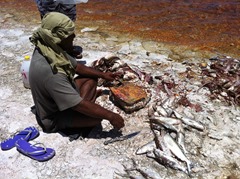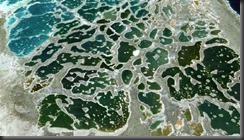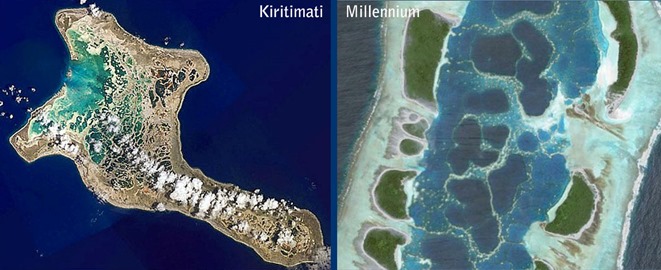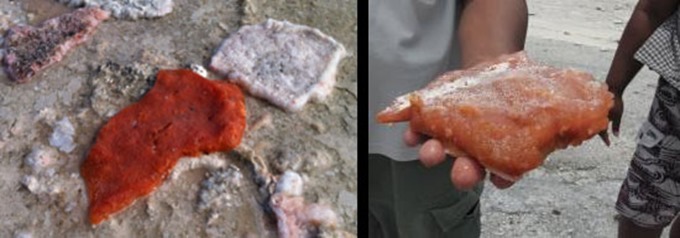 Kiritimati (Christmas Island) has the greatest land area of any coral atoll in the world: about 388 square kilometres (150 sq mi). The atoll comprises over 70% of the total land area of Kiribati, a country encompassing 33 Pacific atolls and islands in three widely separated island groups: the Gilbert Group in the west, the Phoenix Group in the centre, and the Line Islands in the east.
Kiritimati (Christmas Island) has the greatest land area of any coral atoll in the world: about 388 square kilometres (150 sq mi). The atoll comprises over 70% of the total land area of Kiribati, a country encompassing 33 Pacific atolls and islands in three widely separated island groups: the Gilbert Group in the west, the Phoenix Group in the centre, and the Line Islands in the east.
The inland region of Kiritimati Atoll between the lagoon and SE point comprises a system of palaeo lakes (ponds) formed by the stranding, between 1,400-5,000 years ago, of the reticulated lagoon system that once penetrated the full length of the atoll. Live reticulated lagoon systems can be found in many atolls, including Millennium Atoll (Caroline island, Kiribati). Through either or both sea-level fall or uplift, these old reefs were cut off from the tides and show through their fossil fauna that they were once dominated by Poritid, Faviid and Acroporid corals and associated faunas (e.g shellfish) found in today’s lagoons. The reefs were well-developed with some Porites colonies reaching 3.5m in diameter and possibly 500 years of age.
The reticulated reef systems have become partially filled with sediments and consolidated to the extent that they are isolated from tides, capture rainwater and water from the land and, with the salt collected within them, cycle through hypersaline conditions during the common drought periods, becoming flooded during wet periods. The environments in the ponds are highly variable, ranging from near sea-water close to the lagoon, through to 93 parts per thousand (ppt) or more (only a few lakes were measured). Some of the lakes are saline enough to be precipitating significant salt deposits. Based on the satellite image, a few of the ponds appear to be reduced to dried salt.
Figure: Palaeo reefs forming ponds in Kiritimati compared with reticulated reef in Millennium lagoon, Kiribati. Note the small enclosed reef units in each picture, with Millennium lagoon showing what the ponds in Kiritimati would have looked like around 6,000 years ago.
There appears to be two distinct milkfish (Chanos chanos, or baneawa) stocks in Kiritimati. The first stock comprises the milkfish that are able to move between ocean and the lagoon, penetrating up into those ponds that are connected by passages and tidal flows. Some of the ponds connected to the lagoon were artificially connected during the British administration by a system of 3 gates and 12 channels. This includes 15 Fisheries Ponds that have had their water environments altered artificially. These fish appear to be migrating out to the ocean, and juveniles migrating up into the higher reaches of the lagoon. This stock is fished in both the ocean and lagoon.
The second stock is comprised of milkfish of the same species that occupy the inland ponds more-or-less in isolation, being connected with other ponds and possibly the lagoon only during periods of flooding. This stock of milkfish was remarkable in its characteristics and constitutes a wild capture fishery, not for the culture of fish as reported by (Awira et al., 2008). On 29th March 2014 the fish being caught in the ponds were fat and contained ripe gonads. In one pond the fish were aggregated at the site of two springs of water entering the pond, each with a salinity of around 30 ppt. These fish were feeding on the blue-green algae growing at the outflows, and were possibly trying to migrate in response to the signal provided by the relatively fresh water flow. The salinity of the pond was around 69 ppt. In some ponds heavy foam formations were observed as well as die-offs of fish. One such pond had a salinity of 65-85 ppt.
It is possible that the fish in these ponds are completing their life cycle within their pond and that the milkfish populations respond to the drying and flooding of the ponds. Fishermen and the Fisheries Officers reported that these milkfish are highly prized (likely due to their fat content) and that they grow rapidly after rain, even in ponds that have previously died out.
Table: Broad characteristics of the two distinct milkfish stocks in Kiritimati. Observations were made on 31/3/14 and are not suggestive of other times of lunar, tidal or seasonal cycles.
|
Ocean / Lagoon Stock |
Pond Stock |
|
|
Size |
Full size range with large maximum sizes, particularly in the ocean |
Constrained to cohorts of similar size, possibly reset by severe drought (depending on pond) and floods |
|
Fat |
No obvious fat |
Body cavity near vent lined with a thick layer of fat equivalent in thickness to the muscle wall |
|
Gonads |
Unripe |
Well-developed and ripe, near spawning |
|
Behaviour |
No migration behaviour observed; arrangement of gates may be restricting upwards movements of juveniles into ponds due to the “wall of mouths” effect |
Where water inflowing (either a spring into a pond or at gates) fish attempting to migrate down into lagoon |
The ponds are remarkable in their degree of isolation from one another, becoming temporarily connected by flooding only once every 2 or so years. Some are water impermeable to the extent that adjacent ponds can have very different water levels and salinities. The pond system at any one time appears to include those that are near seawater through to dry salt and many gradations in between. Those that are isolated from the lagoon and tidal waters are dominated by the blue-green-algae-bacteria noted by (Mueller-Dombois and Fosberg, 1998) or “orange jelly” algal mats (Figure below). Samples of this jelly were examined under a microscope on 1/4/14 and appeared to be composed of algal cells (in rapid cell division with up to several percent undergoing mitosis), bacteria, diatoms and filaments that could be fungi. The mats are being consumed by the milkfish, confirmed by watching them feed and examining stomach contents during the field trip.
Figure: Orange jelly mat
Figure: Pond showing orange jelly mat concentrated around the shallows
Figure: Palaeo reticulated reefs showing the Orange jelly pond colouration visible by satellite. Note the ponds to the north-west which are infiltrated by lagoon water do not appear to support these algal mats, appearing more blue in the satellite picture.
 It appears that the orange jelly ponds (OJPs) are significant contributors of food to the Kiritimati diet and are highly prized over the more marine stock that migrates between lagoon and ocean. The ponds themselves are probably highly productive and largely self-contained in terms of nutrient cycling and may be self-recruiting much of the time. During the long droughts, they act independently, a few receiving water from groundwater sources, others drying up and killing the fish within them. Occasionally, during sufficient rain the ponds become flooded, allowing for migration of fishes, nutrients and salt between them and allowing for a ‘reset’ in ponds that have died. In terms of food security they are likely to be the most important fishery on the island, returning highly nutritious and prized fish without the need to own a boat or travel into the ocean – and they are well-suited for use during rough weather.
It appears that the orange jelly ponds (OJPs) are significant contributors of food to the Kiritimati diet and are highly prized over the more marine stock that migrates between lagoon and ocean. The ponds themselves are probably highly productive and largely self-contained in terms of nutrient cycling and may be self-recruiting much of the time. During the long droughts, they act independently, a few receiving water from groundwater sources, others drying up and killing the fish within them. Occasionally, during sufficient rain the ponds become flooded, allowing for migration of fishes, nutrients and salt between them and allowing for a ‘reset’ in ponds that have died. In terms of food security they are likely to be the most important fishery on the island, returning highly nutritious and prized fish without the need to own a boat or travel into the ocean – and they are well-suited for use during rough weather.
The orange-jelly ponds are distinct from those palaeo ponds that are connected with the lagoon and which do not contain the orange algal mats. It is possible that the ponds artificially connected with the lagoon by the well-meaning British Administration reduced their productivity by changing the dominant algae and nutrient cycling regime. According to fishermen, production in the lagoon-influenced ponds may be lower than in the OJPs.
The OJPs are likely to be sensitive to ecological disruption. It is already clear that fish in nearby ponds with gates and channels into them had fish without fat and without mature gonads on the day of observation. It is possible that allowing seawater to enter the ponds completely changes their ecosystem. The ponds are also shallow and dish-shaped, which with surface winds may be keeping them well-oxygenated, and the shape of which allows for the development of the orange jelly mats near the edges and to a depth of about 50-60cm. The shallow dish-shape also allows wind to create and blow foam out of the ponds, possibly clearing them of some organic materials and salt which is delivered onto the land. All of these features suggest that any environmental changes caused by human development could disrupt this valuable system of natural ponds which is now delivering a source of high quality protein to the residents of Kiritimati. The main actions of concern are:
1. Any settlements near the ponds could result in nutrient enrichment with unknown effects on nutrient cycling and the growth of the probably highly-productive orange jelly mats. This includes sewage pollution and seep from settlements.
2. The salinity cycles in the ponds are likely to be critical to the growth of the orange-jelly mats and disturbance of this cycle may change the algal food base of the ponds. Hypersaline periods may also act to suppress populations of Tilapia that were observed in some ponds. At present Tilapia are not very abundant, though they were observed in a few of the ponds – removing the hypersaline periods may allow them to become more dominant and affect productivity of milkfish.
3. Any modifications in water regime through creating channels and gates may not be the best outcome and appears to change the ecosystem from orange-jelly dominated to an apparently less productive system. It is possible, that after research has been concluded the gates and channels may be better closed to improve overall productivity.
4. Any changes in the shape of the ponds such as digging them deeper or creating more vertical walls may act to disrupt the nutrient cycling and productivity by increasing the risk of anoxia, reducing the growing area for orange jelly and reducing the formation of wind-driven foam to remove some nutrients and salts.
References
Awira,R., Friedman,K., Sauni,S., Kronen,M., Pinca,S., Chapman,L., Magron,F., 2008. PROCFish Kiribati Country Report: Profiles & Results from Survey Work at Abaiang, Abemama, Kuria and Kiritimati. 1-343, Secretariat of the Pacific Community (SPC).
Mueller-Dombois,D., Fosberg,F.R., 1998. Vegetation of the Tropical Pacific Islands, Ecological Studies ed. Springer Verlag, New York.



